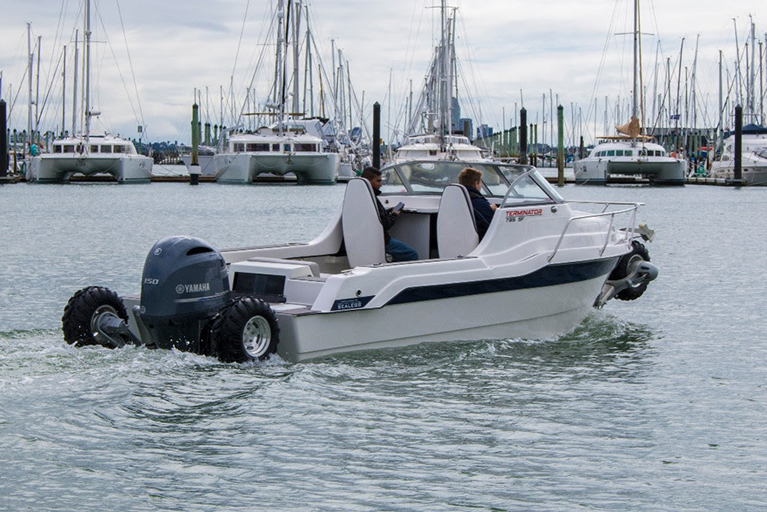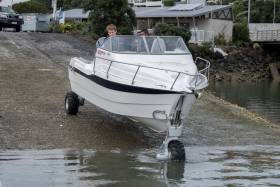Displaying items by tag: Sealegs
Irish and North American Citizen Scientists Co-operate on "SeaLegs" Microplastics Monitoring
Citizen scientists from Westport Aquarium in Washington state, USA, and Galway Atlantaquaria have collaborated on a project to raise awareness about microplastics.
Named “SeaLegs”, the project involved monitoring local water sources for microplastic litter.
From early summer, this year, the trawl teams from Ireland and America were tasked to select a local water source and check for microplastics.
The SeaLegs devices were made from recycled and upcycled materials, and the trawls took place in areas including the Humptulips River and Grays Harbour in Washington state and Galway Bay.
"Kayakers and fishermen and many other water enthusiasts wondered why we were pulling a pair of baby leggings through the local waterways"
Garry Kendellen, of Galway Atlantaquaria said, “I loved meeting people during the trawls, the tights in the water were a great conversation starter, and I was able to talk about Clean Coasts volunteering and the problems of microplastics”.
 Trawls took place in areas including the Humptulips River and Grays Harbour in Washington state and Galway Bay as part of "SeaLegs" microplastics monitoring
Trawls took place in areas including the Humptulips River and Grays Harbour in Washington state and Galway Bay as part of "SeaLegs" microplastics monitoring
“The aquarium has been involved in many projects like this, but this one was really special and thought-provoking,” he said.
Six trials were conducted by the teams. It was agreed that even if the trawls were unsuccessful in their goal of capturing litter and microplastics, they would still be a conversation starter about litter, marine litter, water rights, social behaviour, litter collection/disposal, biodiversity, and citizen science.
Katherine Myrsell, director of Westport Aquarium, said: “Kayakers and fishermen and many other water enthusiasts wondered why we were pulling a pair of baby leggings through the local waterways.”
“After deploying the SeaLegs, there was a lot of work to sort and sieve the samples.
After a day of collecting samples, we had to sift through the mass of organic matter and find microplastics,” she said.
“This was no easy feat as microplastics are fragments of any type of plastic less than 5 mm (0.20 in) in length. The trawl teams had very limited quality microscopes, so it was a painstaking process to sort the samples,” she said.
“After much scanning and sifting, we were able to identify microplastics in almost every trawl. The fibres we discovered could not be confused with anything organic as they were blue, white, and red in colour,” she said.
The findings are in the SeaLegs Project Report
Summary Findings, including team details and a link to the SeaLegs Plastic Survey are here
Videos from the project are here
Terminator 755 Amphibious Boat By Sealegs On Show in Auckland
New Zealand based Sealegs International has announce the coming release of the Terminator 755 Amphibious by Sealegs at the Auckland On Water Boat Show. The craft features System 60, the amphibious enablement system (AES) by Sealegs, and was developed by Terminator Boats.
This latest addition to the expanding amphibious product range demonstrates the on-going efforts and success of the Sealegs AES Strategy previously seen in craft released by Stabicraft and ASIS. Sealegs plans to continue the strategy of developing amphibious craft through offering amphibious systems to global boat manufacturers to widen our product range and reach of customers.
Brazen Composites and its subsidiary Terminator Boats have a long history in building composite craft. The Terminator 755 is the first 100% fiberglass model released with Sealegs that does not feature the Hypalon or Aluminium pontoons previously seen in the rest of the Sealegs range.
 The standard hull and Amphibious Enablement System will have a retail starting price of just $149,000 + outboard, options
The standard hull and Amphibious Enablement System will have a retail starting price of just $149,000 + outboard, options
Sealegs CEO, David McKee Wright said “with every new partner we appoint under the AES strategy, our systems and processes improve to better accommodate the needs of a wider range of boat manufactures. The Terminator 755 demonstrates the ability to leverage the expertise of alternative boat manufacturers, as we benefitted from the skills of our partner, Brazen Composites, to release the all-fiberglass boat. A skillset where Sealegs has limited experience.”
He went on to say “by leveraging the efficient manufacturing base in Malaysia, and the lower cost manufacturing process of fiberglass, we have been able to introduce an introductory price that is better than any other in the Sealegs range.”
The Terminator 755 Amphibious by Sealegs will be available for viewing at the Auckland On Water Boat Show from the 29 September through 2 October 2016, on Sealegs Island, Viaduct Events Centre, Auckland. The standard hull and Amphibious Enablement System will have a retail starting price of just $149,000 + outboard, options and gst. Sealegs will also be running an introductory special until the end of the boat show for just $125,000+gst.
Features of the craft are listed below:
Sealegs System 60 Technology including
All Wheel Drive
Automatic Braking System
Extended Run Time
Power Steering
Hull constructed with DNV certified composite materials
ISO gelcoat, barrier coat, fiberglass, PVC core, vinylester resin
All panels, girders and bulkheads are resin infused under vacuum
250 litre stainless steel fuel tank and fuel level gauge
Engine, fuel and electrical areas with Fire Retardant coating
Swivel helm seats and aft facing seats
Upholstery with marine grade synthetic leather
Stainless steel mast arch, bow rail, boarding ladder and 6 cleats
Fibreglass hard top, curved laminated glass windshield, wipers and side clears
Stainless steel mast arch with rod holders, bow rail, boarding ladder & 6 cleats
Ceredi locker hatches
Self-draining anchor locker
Electrical loom and switchboard including
Battery with isolation switch
Manual and electric bilge pump
Foredeck hatch
The Terminator 755 SF will be on display at the Auckland on Water Boat Show.





























































